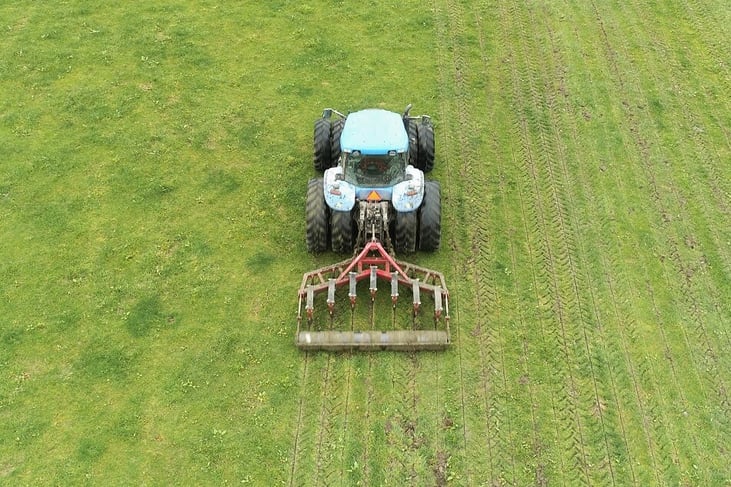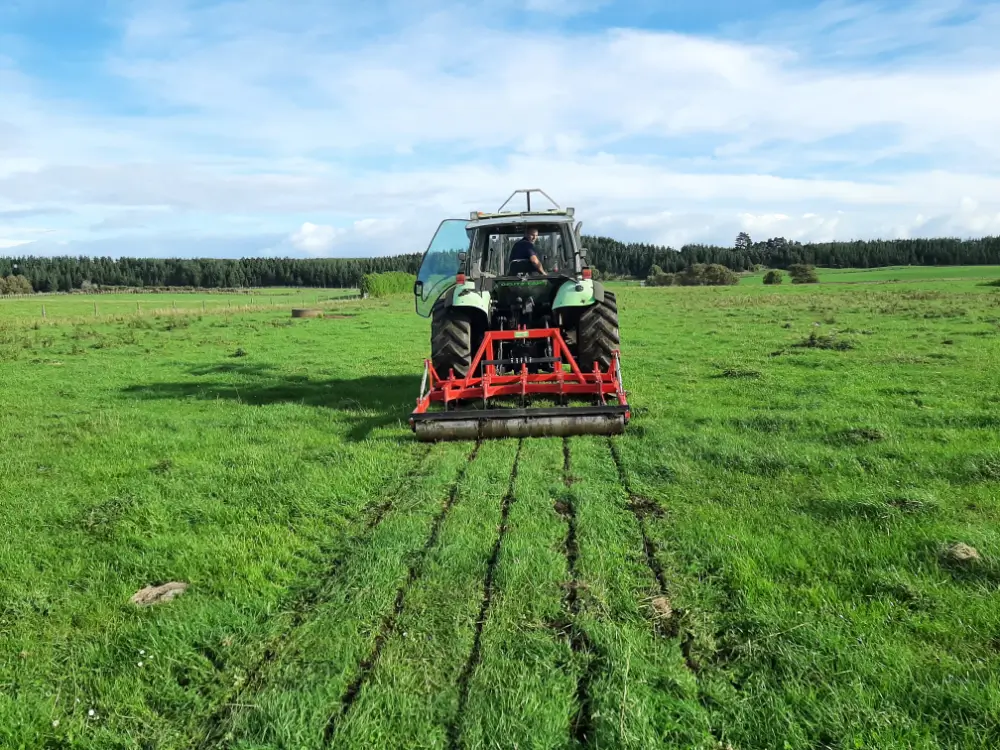Introduction to Soil Aeration and Its Importance'
Subsoil Aeration is the term used to describe the loosening of the subsoil structure along with the removal of any compacted layers. To create a more porous and aerated soil in which nutrients along with water can flow. This increase in soil permeability enables fertilisers and nutrients to flow to the root zone, to be taken up more effectively. And also for the roots themselves to grow more vigorously as the resistance becomes less.
One of the essential elements for plant development is soil aeration. However, while farmers frequently fertilise their fields or irrigate them, soil aeration is frequently overlooked and goes neglected. However, the positive benefits of soil aeration on root activity and growth guarantee is healthy plants, and as a result, excellent yields.
By transferring O2 and CO2 between the earth's pores and the atmosphere, the process of soil aeration provides air supply underneath. It helps prevent crops from going without oxygen and lowers dangerous carbon dioxide levels in the subterranean air if they go too high.
The actual depth of the subsoil will differ from farm to farm, but it is obvious that it is significantly deeper than the working depth of the majority of traditional tillage techniques. Most conventional tillage techniques, which concentrate on the upper soil layers, are unable to penetrate this layer of soil, which gradually compacts over time and restricts the root growth of pastures and crops, resulting in reduced yields. The more vigorous root growth allows roots to grow to deeper levels, making the pasture and crop more resilient to summer dry’s and winter wet periods.
'Understanding Subsoil Aerators: What Are They?'
Many become confused between ‘Aerators’ & ‘Subsoil Aerators’ believing they do the same job but in fact they do not.
‘Aerator’ is a term commonly used to describe a spike roller type of aerator which perforates the ground with holes to allow air, water and nutrients to penetrate into the grassroots (often using concrete weights to penetrate the ground).
Given that the weight of the average 120hp tractor that’s commonly found on NZ farms is around 5,000kg (compare that to a golf cart weighing 400-500kg) or the total weight of a 15-member rugby team of 1,500kg compared to the 305,000kg weight of the average 610 head NZ dairy herd it’s pretty obvious you’re going to be dealing with a whole different level of compaction issues in an agricultural situation than your local council has at the bowling green or golf course. 500kg of dairy cows v rugby players and 120hp tractors v electric golf carts, the much greater weight and compressive force from livestock and heavy machinery is going to create compaction issues much deeper into lower soil layers. As in, the compaction is going to reach down into the Subsoil layers which are 300mm and below.
Subsoil Aeration is the method of aerating that actually reaches deep into the subsoil! The prime difference between these two styles of aerators is a Subsoil Aerator uses shanks/legs that penetrate down into those lower layers, with a foot that provides a lift as the subsoil aerator runs through the ground. This upward-lifting effect creates fractures in the soil, making it more permeable thereby removing compaction & making the soil looser.
.jpg?width=800&height=450&name=304%20Panerazer%20(3).jpg)
'The Role of Subsoil Aerators in Boosting Crop Health'
What part does soil aeration play in the wellbeing of roots?
To breathe and release energy from the glucose-oxygen reaction for their requirements, plant roots need air oxygen. Poorly aerated soils prevent roots from breathing properly, depriving them of oxygen, which causes them to wither. The plant eventually dies because roots are needed to receive nutrients and water. Aeration has effects on soil that go beyond crop development. Aerobic earth-dwelling bacteria and adequate oxidation require soil aeration.
Soil compaction prevents the flow of nutrients & water to the roots of your grass & crops, leading onto lower dry matter in pasture & lower yields in crops. Subsoiling works by lifting the soil & fracturing the structure to create a looser & more 'aerated' soil that allows nutrients to flow & roots to grow.
- Eliminates Compaction: By aerating soils you remove compaction damage from pugging & machinery traffic. Aeration is particularly important in high traffic areas such as water troughs, gateways & feed out areas where compaction levels are higher than the rest of the paddock. Aerated soils enable more vigorous & deeper root growth for healthier crops & plants.
- Deeper Root Structure: Soil compaction seriously hampers root growth & the depth to which roots can grow, by sub soiling the ground is broken up to provide conditions for easier root growth, this results in more vigorous & deeper root structures that take up more nutrients & provide greater resilience in dry spells & other weather events, enabling pastures & crops to 'hold on' for longer.
- Greater fertiliser uptake: When soils are compacted or do not have sufficient permeability, fertiliser is wasted. This is due to it not absorbing into the ground & simply vaporising or washing off the surface & not into it. When soil is aerated & permeable the fertiliser absorbs into the soil & is more readily taken up by the roots.
- Greater Soil Porosity: Greater porosity of soils means the level of oxygen is increased as it flows more freely in permeable ground, this speeds up plant growth as more oxygen becomes available at root level. On the other hand compacted soils decrease oxygen levels & increases the amount of carbon dioxide in the ground, this causes an eventual slow down in growth.
- Increase in pasture growth: This is the reason why farmers aerate soils! The combined factors of subsoil aeration have been proven to increase pasture dry matter yield by 28% in the right conditions, increasing growth, production and profits.
'How Subsoil Aeration Improves Soil Drainage'
A subsoil aerator will reach deep into your subsoil layers to fracture the soil structure enabling greater water, air and moisture flow through all soil layers it's working in. Whereas most soil aerators will only work the topsoil due to a lack of working depth, not to mention the irony of claiming to fix compaction by forcibly rolling spikes into the ground! (at times with the aid of concrete weights!)
If you have subsoil compaction issues on your farm its important to make sure you correctly identify the causes (prevention is better than cure) and ensure you have a full understanding of the scope of the compaction issue in your pastures/paddocks before beginning any remediation, only then will you really know what options are going to deliver the best result.
Some common symptoms of subsoil compaction include:
- Water ponding
- Shallow roots
- Low fertiliser response
- Improved soil drainage: In the aerated soils there is also greater drainage of surplus ground water, this reduces & eliminates ponding & surface water on your paddocks, along with improved soil drainage comes a benefit of reduced runoff as the water is 'soaked' into the ground along with any nutrients that enhance growth.

'Best Practices in Subsoil Aeration'
When is the best time to subsoil aerate? It’s a question we’re often asked by farmers looking to begin subsoil aeration.
Whilst the best time for aeration is typically understood to be Spring, there has also been some good reasons come to light in recent times that would support aerating your subsoil in Autumn.
The reasons for each are somewhat different, up for debate & really depend on each land owner's unique situation and soil type. In this blog we give a brief explanation of the reasons you should aerate in spring, and may also do in Autumn.
Why you should aerate in Spring
Spring is largely heralded as the best time to aerate your subsoil as it’s at the beginning of the growing season when you will see the results of your aeration actions. By removing winter induced pugging & compaction damage you increase the soil porosity which in turn has the following effects:
- Increase soil porosity which enables water, nutrients & oxygen to reach lower root levels.
- Less compacted soil enables roots to grow more vigorously and grow into lower levels of the subsoil, gaining access to more nutrients and moisture.
The above two effects result in a more healthy pasture or crop which will yield more as well as being more resilient to droughts and dry times.
Results of Spring Aeration:
- Increased pasture growth or crop yield
- More resilient pasture/crop which can withstand drought and dry more as roots are growing into lower subsoil layers with moisture
Why you should aerate in Autumn
Some farmers with soil which tend to be prone to water logging or excess water ponding through the winter months, have found aeration in Autumn can help to reduce or remove those moisture issues.
Compacted soil layers & plough pans create hard layers which water cannot drain through, or at best reduces the rate of drainage. Under wet conditions this compacted soil layer impedes the drainage of water increasing the risk of:
- Root disease
- Surface Runoff
- Water ponding
- Pugging
- Surface water reduces ground temperatures, which in turn reduces pasture growth & can increase the time in which pasture begins to grow when Spring arrives.
Most people will find aerating in spring allows them to reap the growth benefits of that season as well as leave their soil ready for the following winter, with no need to aerate again in Autumn.
However, those who have not aerated in spring, or who have soil that is particularly prone to winter compaction and water logging, may find Autumn aeration to be beneficial to their pasture, aeration being a process that reduces pugging and helps the pasture come through winter in the best possible shape.
To conclude, there are many benefits of subsoil aeration, but to sum it up as a general increase in pasture growth or crop yields of 20% when done correctly (more in some circumstances). You can purchase Subsoil Aerators from us at Rata Equipment or through our New Zealand or Australia Rata Dealers.
References
https://eos.com/blog/soil-aeration/


.webp)